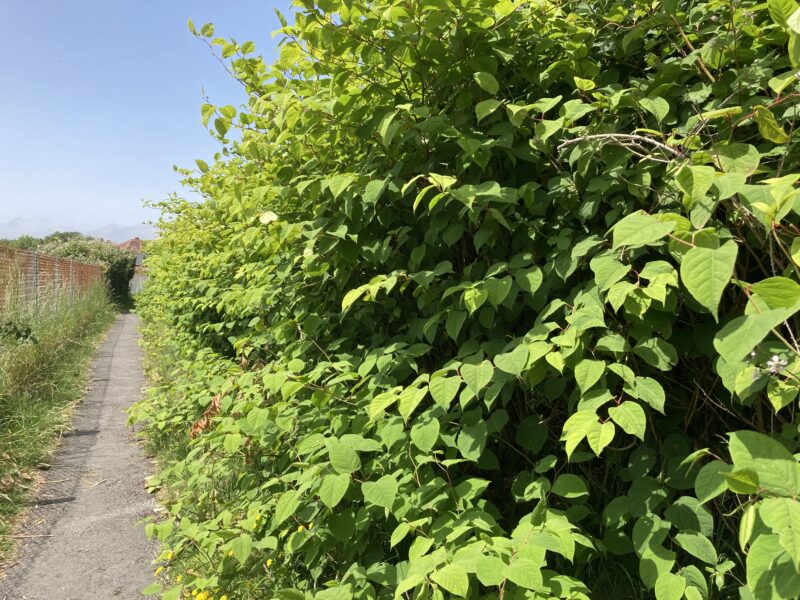SOME householders who live by a large area of Japanese knotweed-infested land in Llanelli have resorted to taking their own steps to deal with the invasive plant because it is creeping up to their gardens.
The land is surrounded on three sides by homes on Gower View, Heol Goffa, Warner Place and Llys Warner. The southern edge abuts a footpath, the other side of which is special school Ysgol Heol Goffa.
Around a third of the land – the section closest to the school – is unregistered, according to Land Registry records. The remaining land is privately-owned.
It is not clear when the knotweed took root on the land, which local people say was a quarry many years ago before waste was tipped there. It is also not clear what steps have been taken to control it, although some residents say the land was effectively flattened by an earth-mover in more recent years.
Vicky Honeybun, of Gower View, said the knotweed has climbed up her back garden wall at times. She said she felt the situation was wrong and that more action should be taken about the fast-spreading and resilient plant.
“Residents have to deal with the consequences of it,” she said.
An elderly woman on Gower View said a neighbour had sprayed knotweed directly behind their garden walls to keep it at bay.
The Local Democracy Reporting Service was told that one of the houses on Gower View had to have a cash buyer when it was put up for sale because no company would mortgage it on account of the knotweed problem. A resident also claimed the value of another house was reduced by £30,000 because of the plant, which bursts into life above ground in the spring and summer before dying back.
It is an offence under the 1981 Wildlife and Countryside Act to plant or cause invasive knotweed to grow in the wild. The official advice is not to spray it unless you have the appropriate skills and experience. It is offence to dispose of knotweed with your garden waste.
Stuart Hopkins, who moved into his Llys Warner home in 2004 and is close to the knotweed-infested land, said action was taken initially by a developer to control the spread of the plant, but that this appeared to stop around a couple of years ago.
Mr Hopkins said he has been in touch with Llanelli politicians over the years about the issue, including Cllr Rob James, and also with Carmarthenshire Council.
“The knotweed is getting closer,” he said. “It’s virtually on the land of two houses opposite. It’s totally frustrating.”
The 80-year-old’s wife, Mary, said she and her husband were constantly keeping an eye on the knotweed. She added: “He (Stuart) is stressed out.”
Mr Hopkins – a former Carmarthenshire councillor who represented Swiss Valley – said he contacted a firm of solicitors at one point to try to help, but he said the cost of the required work was prohibitive.
Gareth Bowen, of Warner Place, said:
“The knotweed is getting worse, especially up at the top end. Residents are spraying. People have tried to sell their houses because of it.”
Mr Bowen said the land was landscaped at one point and looked “nice and tidy”, and wondered if contaminated soil tipped there in the past was the source of plant’s presence.
Cllr James, who represents Llanelli’s Lliedi ward, spoke of “a forest of knotweed” off Heol Goffa during a debate at a Carmarthenshire Council meeting last year.
The Labour group leader had proposed a motion which called on the Plaid-Independent administration to use measures under the 2014 Anti-Social Behaviour, Crime and Policing Act to tackle knotweed on private land that had a detrimental effect on the quality of life locally and was persistent and unreasonable.
The motion was amended by the Plaid-Independent group to include a line calling on the Welsh Government to urge other councils to consider taking similar action.
The amended motion was supported and then went to cabinet for consideration, but cabinet declined to take further action because it said it would be hard to resource and would also put Carmarthenshire out of step with other Welsh councils.
Speaking to the Local Democracy Reporting Service this week, Cllr James said he had been liaising with residents whose homes backed onto the knotweed-blighted land for five years.
Cllr James said felt cabinet was “sticking their head in the sand” on the issue and that the situation was only going to get worse.
A council spokeswoman said anyone who saw Japanese knotweed being spread should contact their local police station because knotweed offences under the Wildlife and Countryside Act were enforced by the police.
She said the council’s grounds division didn’t have a record of complaints relating to knotweed or requests for treatment for the land in question.
The council, meanwhile, is going to relocate Ysgol Heol Goffa, whose border is just a few feet away from the nearest knotweed, to a new site.
Asked what plans it had for the current Heol Goffa site once the school relocates, and whether it was concerned that the presence of knotweed so close to the school boundary may affect its disposal, the spokeswoman replied:
“We currently do not have any plans for the current Heol Goffa site following the relocation of the school. This is something we will consider as we move forward. We will also work with colleagues to understand the implications of the knotweed and its proximity to the school site.”
The Local Democracy Reporting Service wrote to the address of the landowner provided on the Land Registry title to ask them to get in touch about the concerns raised by residents. A replica letter was sent to the Companies House address of the development company which built Mr Hopkins’s home on Llys Warner. No-one responded at the time of going to press.
Please donate here: Support Carmarthenshire News Online Thank you for supporting independent journalism and contributing to the future of local news in Carmarthenshire. Carmarthenshire News Online has been dedicated to providing unbiased and trustworthy news, free from commercial or political influence. By donating as little as £1, you can help ensure the continuation of this important source of information for the community. Your contribution will have a significant impact on the sustainability of independent journalism. If you're looking to enhance your brand's visibility, we also offer advertising opportunities on our Livestream and podcasts. Our special offers provide excellent value for reaching our engaged audience. To learn more about these opportunities and to discuss your advertising needs, please feel free to call or text us at 07308598604. Thank you again for your support, and together we can ensure the availability of quality local news for Carmarthenshire and beyond.
Please donate here: Support Carmarthenshire News Online





